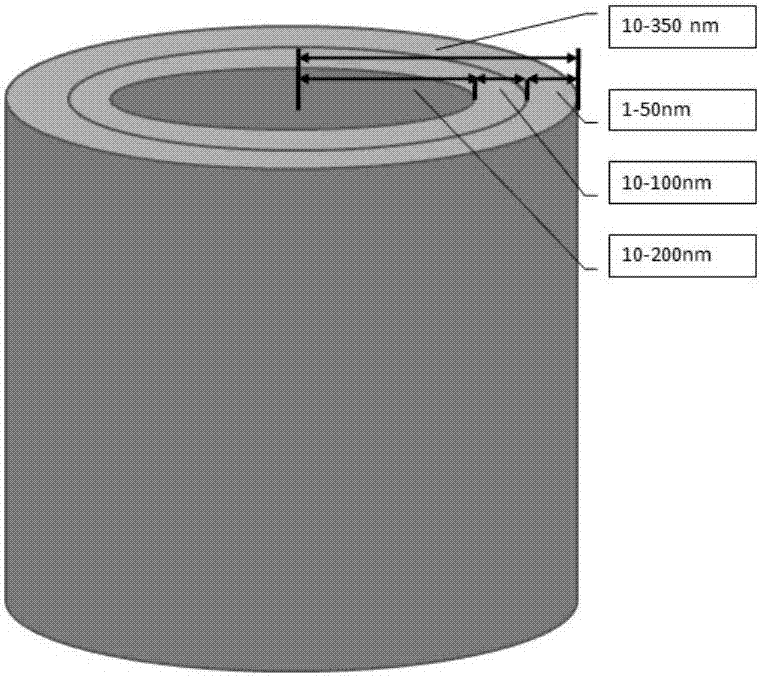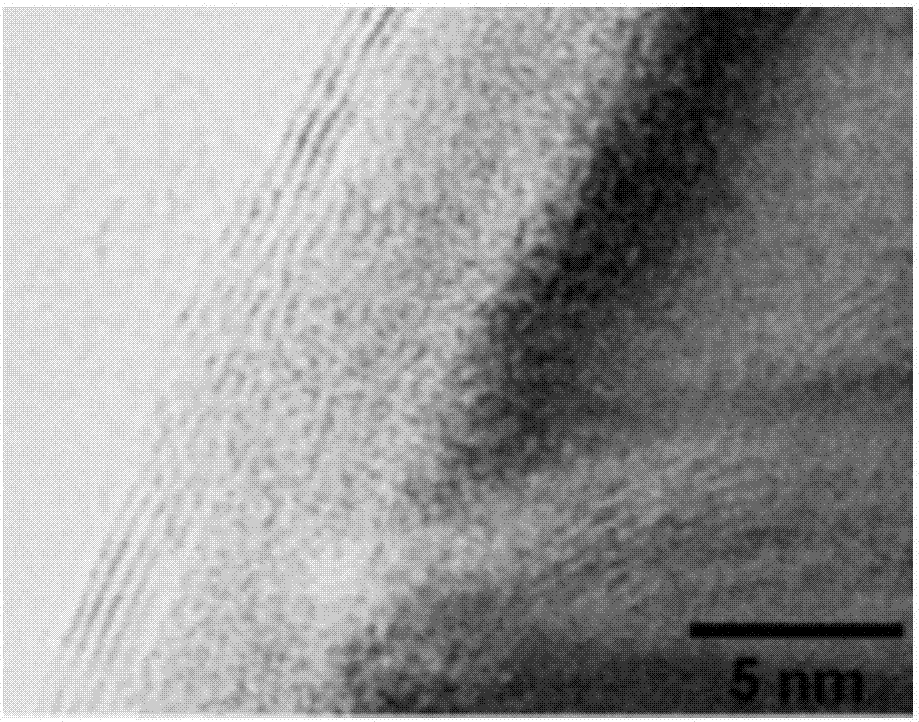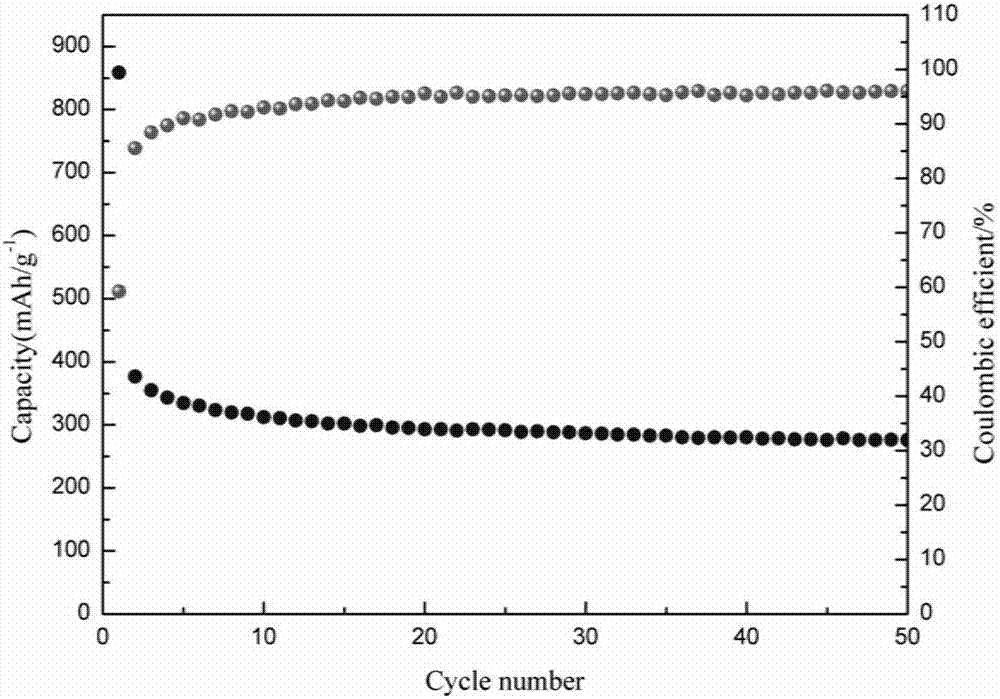Porous carbon nanometer tubular material and preparation method and application thereof
A carbon nano, tubular technology, applied in the field of porous carbon nano tubular materials and its preparation, materials with coaxial double-layer hollow tubular structure and its preparation, can solve the problems of poor performance cycle stability, weak sodium storage capacity, layer spacing Incompatibility and other problems, to achieve the effect of low cost, increase the carbon layer spacing, and promote the insertion and extraction process
- Summary
- Abstract
- Description
- Claims
- Application Information
AI Technical Summary
Problems solved by technology
Method used
Image
Examples
Embodiment 1
[0046] Stir 20mL of 1.0mol / L nickel nitrate solution, 1% polyethylene glycol and 0.5mL of 1mol / L sodium hydroxide evenly to carry out hydrothermal reaction. The holding temperature is 160°C and the holding time is 24h. Then, it was washed with deionized water for 3 times, and then with absolute ethanol for 2 times, and then dried in a vacuum oven at 60° C. for 10 hours to obtain transition metal nanowires. Add 0.08g of transition metal nanowires, 8.8g of dopamine, and 1g of CTAB into 1L of water, stir evenly, place in a reactor for hydrothermal reaction, the reaction temperature is 180°C, and the reaction time is 16h. After suction filtration, washing and drying, carbon-transition Metal nanowire precursors. The precursor was carbonized under nitrogen atmosphere, the carbonization temperature was 900°C, the carbonization time was 2h, and the heating rate was 2°C / min. Subsequently, the high-temperature carbonized product was repeatedly washed with dilute acid solution and water...
Embodiment 2
[0049] Stir 20mL of 1.5mol / L nickel sulfate solution, 1% polyethylene glycol and 0.5mL of 1mol / L sodium hydroxide evenly, and carry out hydrothermal reaction. The holding temperature is 180°C and the holding time is 24h. Then, it was washed with deionized water for 3 times, and then with absolute ethanol for 2 times, and then dried in a vacuum oven at 60° C. for 10 hours to obtain transition metal nanowires. Add 0.08g of transition metal nanowires, 9.6g of dopamine, and 1g of sodium dodecylbenzenesulfonate into 1L of water, place in a reaction kettle for hydrothermal reaction, the reaction temperature is 190°C, and the reaction time is 24h. After suction filtration, washing and drying, A carbon-transition metal nanowire precursor is obtained. The precursor was carbonized under nitrogen atmosphere, the carbonization temperature was 1000°C, the carbonization time was 4h, and the heating rate was 2°C / min. Subsequently, the high-temperature carbonized product was repeatedly washe...
Embodiment 3
[0052] Stir 20mL of 2mol / L nickel chloride solution, 1% polyethylene glycol and 0.5mL of 1mol / L sodium hydroxide evenly to carry out hydrothermal reaction. The holding temperature is 200°C and the holding time is 24h. Then, it was washed with deionized water for 3 times, and then with absolute ethanol for 2 times, and then dried in a vacuum oven at 60° C. for 10 hours to obtain transition metal nanowires. Add 0.08g of transition metal nanowires, 10.4g of dopamine, and 1g of sodium stearate into 1L of water, place in a reactor for hydrothermal reaction, the reaction temperature is 200°C, and the reaction time is 24h. After suction filtration, washing and drying, carbon-transition Metal nanowire precursors. The precursor was carbonized under nitrogen atmosphere at 1100°C, the carbonization time was 4h, and the heating rate was 2°C / min. Subsequently, the high-temperature carbonized product was repeatedly washed with dilute acid solution and water, then placed at 70° C., and vacu...
PUM
| Property | Measurement | Unit |
|---|---|---|
| thickness | aaaaa | aaaaa |
| thickness | aaaaa | aaaaa |
| concentration | aaaaa | aaaaa |
Abstract
Description
Claims
Application Information
 Login to View More
Login to View More - R&D
- Intellectual Property
- Life Sciences
- Materials
- Tech Scout
- Unparalleled Data Quality
- Higher Quality Content
- 60% Fewer Hallucinations
Browse by: Latest US Patents, China's latest patents, Technical Efficacy Thesaurus, Application Domain, Technology Topic, Popular Technical Reports.
© 2025 PatSnap. All rights reserved.Legal|Privacy policy|Modern Slavery Act Transparency Statement|Sitemap|About US| Contact US: help@patsnap.com



